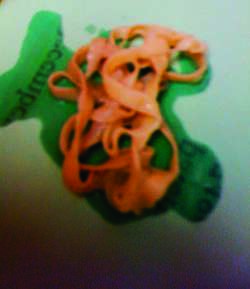Diphyllobothrium
(redirected from Diphyllobothrium yonagoensis)Also found in: Encyclopedia.
Diphyllobothrium
[di-fil″o-both´re-um]a genus of large tapeworms. D. la´tum is the broad or fish tapeworm, an intestinal parasite of humans, dogs, cats, and other fish-eating mammals.
Miller-Keane Encyclopedia and Dictionary of Medicine, Nursing, and Allied Health, Seventh Edition. © 2003 by Saunders, an imprint of Elsevier, Inc. All rights reserved.
Diphyllobothrium
(dī'fil-lō-both'rē-ŭm),A large genus of tapeworms characterized by a spatulate scolex with dorsal and ventral sucking grooves or bothria. Several species are found in humans, although only one, Diphyllobothrium latum, is of widespread importance. Abbreviated taxonomy: Platyhelminthes, Cestoda, Eucestoda, Pseudophyllidea, Diphyllobothriidae, Diphyllobothrium
[G. di-, two, + phyllon, leaf, + bothrion, little ditch]
Farlex Partner Medical Dictionary © Farlex 2012
Di·phyl·lo·both·ri·um
(dī-fil'lō-both'rē-ŭm)A large genus of tapeworms (order Pseudophyllidea) characterized by a spatulate scolex with dorsal and ventral sucking grooves, or bothria. Several species are found in humans, although only one, Diphyllobothrium latum, is of widespread importance.
[G. di-, two, + phyllon, leaf, + bothrion, little ditch]
Medical Dictionary for the Health Professions and Nursing © Farlex 2012
Diphyllobothrium
(di-fil?o-bo`th're-um) [L. Diphyllobothrium, fr di- + Gr. phyllon, leaf + Gr. bothrion, pit]A genus of tapeworm of the order Pseudophyllidea, marked by a scolex with two bothria (slitlike grooves). The genus was formerly called Dibothriocephalus.
Diphyllobothrium cordatum
A species infesting dogs and seals in Greenland. The plerocercoids are occasionally found in humans. Synonym: heart-shaped tapeworm
Diphyllobothrium erinacei
A species infesting dogs, cats, and other carnivores. Larval stages are occasionally found in humans.
Diphyllobothrium latum
A species that is native to Scandinavia, the Baltics, and western Russia, and is now found in North America, esp. the Pacific Northwest, that infests fish and mammals. The adult lives in the intestine of fish-eating mammals, including humans. It is the largest tapeworm infesting humans and may reach a length of 50 to 60 ft (15.2 to 18.3 m); the average is 20 ft (6.1 m). The eggs develop into ciliated larvae that are eaten by small crustaceans called copepods. The larvae pass through several stages in the copepods and develop further after the copepods are eaten by fish, finally encysting in fish muscle. People acquire the infection by eating raw or poorly cooked fish that contains cysts. Infection can be prevented by thoroughly cooking all freshwater fish or by keeping the fish frozen at -10°C (14°F) for 48 hr before eating. Synonym: broad tapeworm; fish tapeworm See: illustration
illustrationSymptoms
Patients often report abdominal pain, weight loss, digestive disorders, progressive weakness, and symptoms of pernicious anemia because the worm absorbs ingested vitamin B12 from the gastrointestinal tract.
Treatment
Praziquantel is used to treat the infestation.
Medical Dictionary, © 2009 Farlex and Partners
